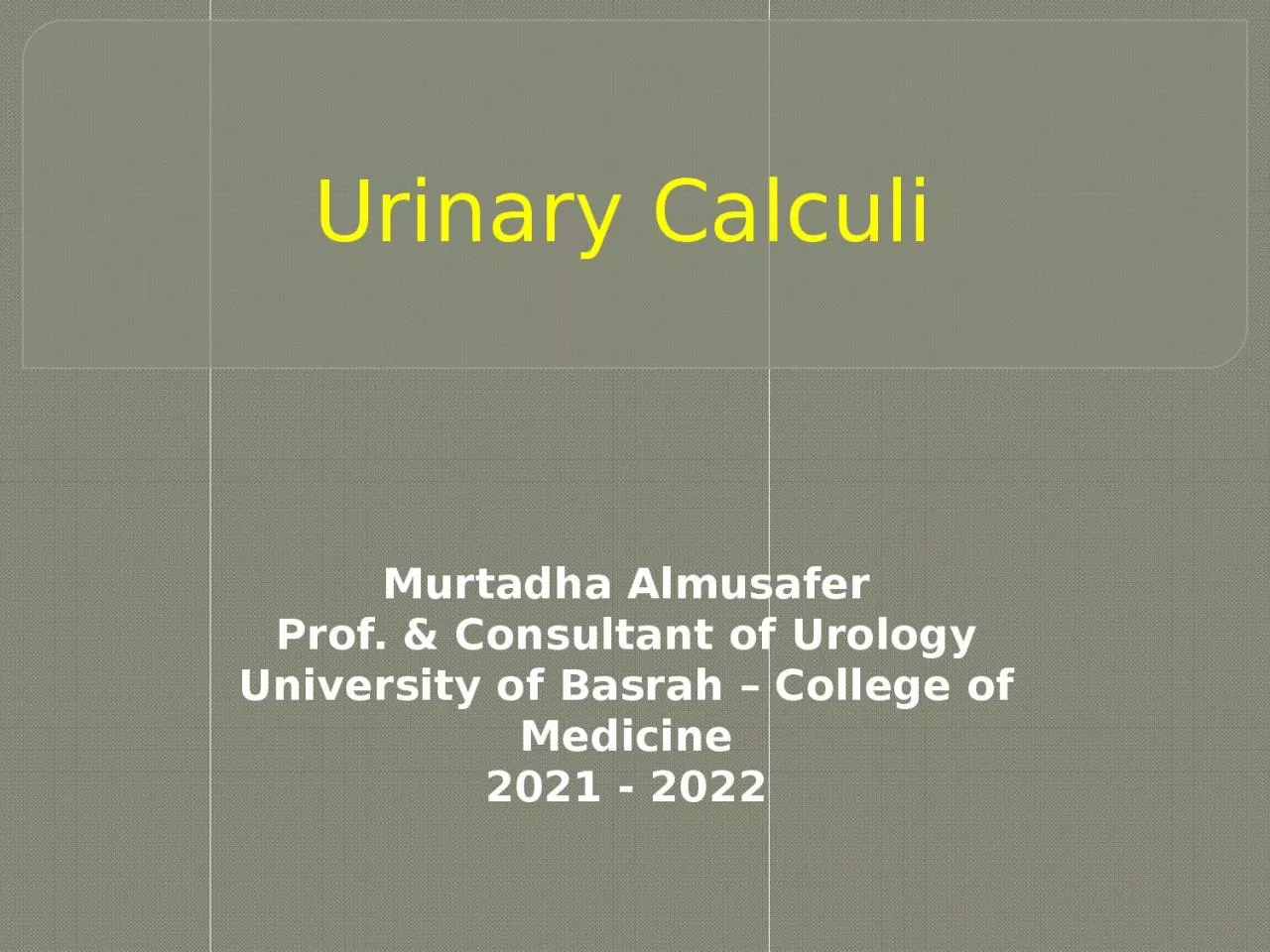

Almusafer Prof amp Consultant of Urology University of Basrah College of Medicine 2021 2022 Anatomical Landmarks Objectives Identify the main risk factors Impact of COVID19 on patients with urinary calculi ID: 998334
Download Presentation The PPT/PDF document "Urinary Calculi Murtadha" is the property of its rightful owner. Permission is granted to download and print the materials on this web site for personal, non-commercial use only, and to display it on your personal computer provided you do not modify the materials and that you retain all copyright notices contained in the materials. By downloading content from our website, you accept the terms of this agreement.
1. Urinary CalculiMurtadha AlmusaferProf. & Consultant of UrologyUniversity of Basrah – College of Medicine2021 - 2022
2.
3. Anatomical Landmarks
4.
5. Objectives:-Identify the main risk factors.-Impact of COVID-19 on patients with urinary calculi-Know the types of urinary calculi.-Diagnose by (history, physical examination, investigations, imaging) & know different methods of treatment & recognize those patients with urinary calculi who need urgent intervention due to complications.-Know how to prevent stone recurrence.
6. You should Know1. The emergent & non-emergent conditions2. Impact of COVID-19 on patients with urinary calculi
7. Aetiology & risk factors1.Dietetic: High energy-dense diet may increase the incidence of urinary calculi.High sodium intake and vitamin A deficiency also increase the incidence of urinary calculi.2. Altered urinary solutes and colloids: Dehydration & reduction of urinary colloids which adsorb solutes3.Decreased urinary citrate
8. 4. Urinary infection with urea-splitting bacteri: Streptococci,Staphylococci and especially Proteus spp.5.Inadequate urinary drainage and stasis6.Prolonged immobilization7.Hyperparathyroidism8. Occupation: Patients with Sedentary works have higher incidence of urinary stones.
9. 9. Climate: Individuals living in a hot climate are more prone to dehydrationwhich increase the incidence of urinary stones.10. Family history: also increase its incidence.11. Medications: as Indinavir, and triametrene.12. Structural and anatomical abnormalities of the urinary tract.
10. Stone Varieties1- Calcium calculi: It accounts for 85% of urinary stones. it includes calcium oxalate and calciumphosphate calculi. 2-Uric Acid Stones-It accounts for less than 5% of all urinary calculi.-They are usually formed in male patients with gout, rapid weight loss and thosewith myeloproliferative diseases.-Those patients usually have urinary PH≤5.5-Pure UA stones are radiolucent
11. 3-Struvite Stonescomposed of magnesium , ammonium and phosphate (MAP). It frequently found& tends to grow in alkaline urine so it is more common in women with recurrentU.T.I. with urea splitting organisms.4-Cystine Stones-usually secondary to inborn error of metabolism.-Uncommon-Appear in acidic urine-They are opaque because they contain sulphur-Very hard
12. 5-Xanthine Stones -usually secondary to deficiency of xanthine oxidase enzyme. -Extremely rare 6) Other rare stones: as Indinavir, Silicate and Matrix stones.
13. History
14. General Examination
15. Local ExaminationRenala. Percussion over kidney produces a stab of pain & may be tenderness on deep palpation b. Palpable loin swelling is rare due to hydronephrosis or pyonephrosis.
16. UretericDuring attack of ureteric colic there is rigidity of lateral abdominal muscle but not as a rule, of rectus abdominis.
17. VesicalMay be normal, there may be suprapubic tenderness. Vaginal exam.: occasionally large calculus is palpable in female.
18. UrethralMay be palpable distended bladder due to retention of urine, or palpable urethral stone or showing urethral stone
19. Bimanual Examination of Kidneys
20. Renal Angle Tenderness (Kidney Murphy Sign)
21. Investigations1. Urinalysis (G.U.E.): Look for RBC, WBC, Crystals, and pH.2. Blood investigations: as B.urea, S.creatinine.Imaging studies include:1.K.U.B.: To look for radio opaque shadows. About 90% of renal stones are radio-opaque. The most radiolucent stones are pure uric acid stones, pure cysteine stones and matrix stones.
22. 2. I.V.U.(EU): to look for filling defects and give an idea about the renal function.3. Abdominal ultrasound4. CT-scan: helical CT-scans are now the imaging modality of choice for patientspresenting with acute ureteric colic, While M.R.I. is a poor study for documentation of urinary stones.5. Nuclear scintigraphy.
23. Ultra-sonography
24. X-Ray characteristic
25.
26. Staghorn Renal Stones
27. CT
28. TRTConservative TRT a. Increase fluid. b. Dissolution agents: oral alkalinizing agents which include Na or K bicarbonate and k citrate.
29. TRT of Acute PyelonephritisA patient with obstructive ureteral calculi with fever ( acute pyelonephritis ) requires: a. Admission: IV line, Urine, & blood culture. b. I.V fluid, antipyretics, & analgesics. c. Broad spectrum antibiotics until results of urine C&S d. Emergent drainage like by placement of DJ stents or P/C nephrostomy.
30. ESWLIt can be considered for those patients with renal stones, size(<25 mm) and those with failed conservative treatment.
31. PCNL
32. RIRS
33. Laparoscopic Surgery
34. Open Surgery
35. TRT of Ureteric Stones
36.
37. Bladder Stones
38. PreventionIn bilateral & recurrent stone formers: 1.Serum calcium 2.Serum uric acid 3.Urinary urate, Ca & Phosphate in 24 hr collection,& urine should be screened for cystine. 4. Analysis of any stone passed. 5. Dietary advice 6.Drink plenty of fluid. 7.Drug TRT: Idiopathic hypercalciuria: Bendroflumethiazide 5mg.Allopurinol & urine alkalinization
39. Impact of COVID-19 on urinary stones:1.Homestay with physical inactivity & consequent weight gain 2.Due to fear of visiting outpatient, there will be more incidence of complications and if the patient has DJ stents, there is high incidence of encrustation.
40.